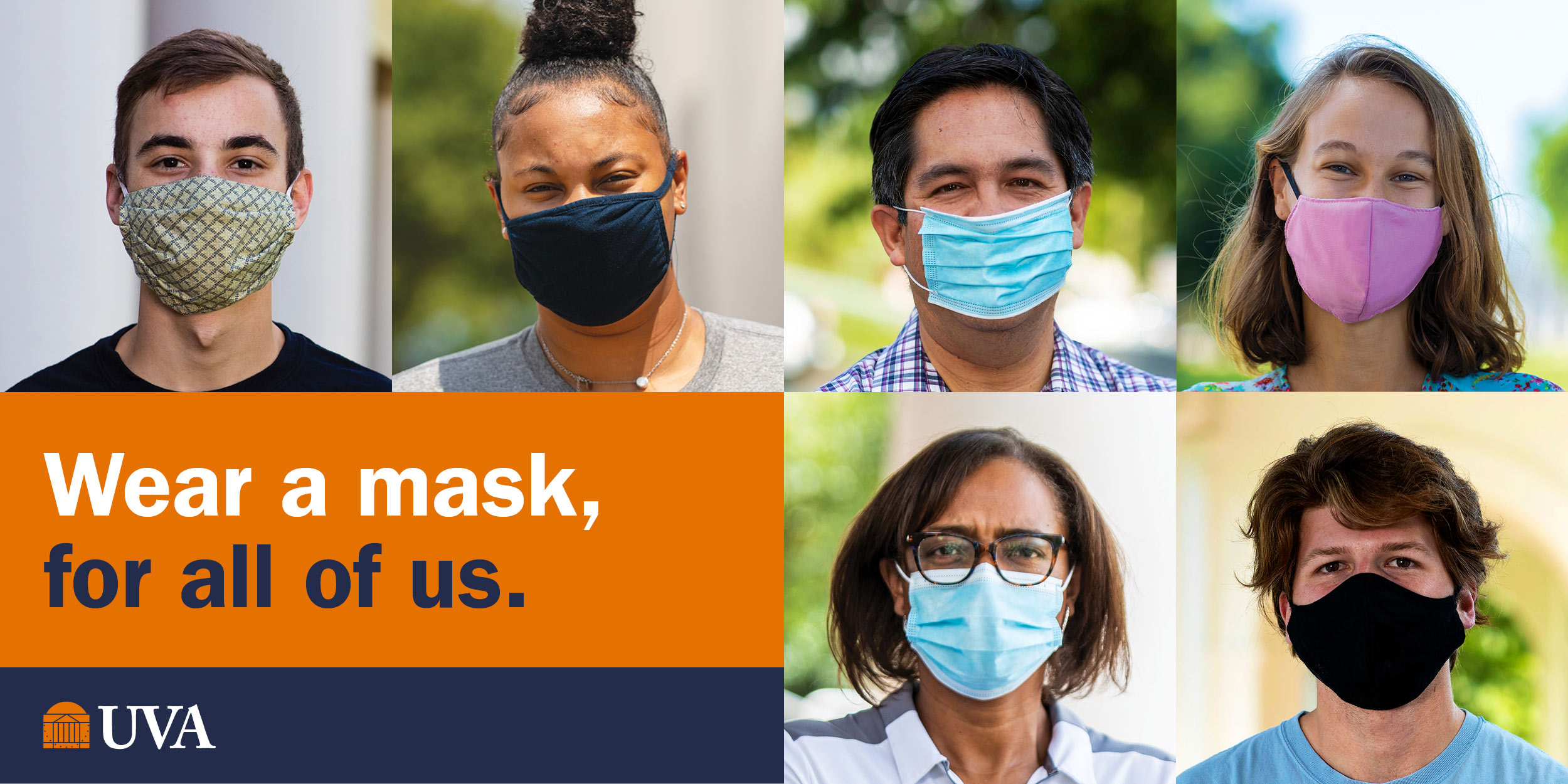Good information is vital to good decision-making.
In dealing with COVID-19, University of Virginia officials understood they needed good information on the virus and how it was affecting students, faculty and staff on Grounds. In August, UVA launched a COVID Tracker that is updated daily with key public health data, including the number of coronavirus cases reported within the University community.
From late August early November, the COVID tracker site received nearly 600,000 hits. While the bulk of these were from Virginia, the site was tracked by people around the country, including Vermont, Texas, Oregon, Washington, North Carolina, Tennessee, California and Florida.
Amassing constantly changing data and presenting it in a user-friendly form is no easy task. A team of UVA employees spanning the academic and medical center enterprises works together to write code and crunch numbers from many different sources each day, a job some of the employees liken to solving puzzles. The group has been together in this effort since the start of the pandemic.

In March, Glenn Wasson, administrator of analytics and performance management at UVA Health, assembled a small team to collect COVID-19 information on Grounds and at the Medical Center – how many employees and students are infected, how many people have been tested – to aid University administrators.
“We receive the results of several different kinds of COVID tests that UVA is using, polymerase chain reaction tests from the UVA COVID clinic, swab-based tests you can get at the Student Activities Building, and saliva tests you can get from a number of different sites,” Wasson said. “And we take the results from all of those testing platforms and route them to the appropriate group for follow-up – Student Health if you’re a student, Employee Health if you’re an employee. We also load results into medical records in case you become a patient and the physicians need to know the results of test you have had.”
Wasson’s team, all of whom work remotely, initially designed the dashboard as a mechanism to help University operations. Later, they developed the dashboard website to keep the University community informed about cases, testing and the state of the pandemic at UVA.
“UVA’s Virus Management Operations Team wanted a way to report to the community,” Wasson said. “We report to regulatory agencies like the Virginia Department of Health and [the U.S. Department of Health and Human Services] and they publish aggregate information, but they wanted a way to report on what is happening in our local area.”
Wasson’s team needed to make the information easily accessible and understood for the public website.
“The primary designer of the dashboard is Wendy Repass,” Wasson said. “She listened to people’s ideas, [and] put together a bunch of mock-ups. A number of different decision-making groups reviewed the mock-ups, people from the health system and eventually administration, and they signed off.”

Glenn Wasson is the team leader and Wendy Repass is the tracker’s primary designer.
Repass, who works for Wasson on the UVA Health analytics team, is a musician and UVA art major who parlayed her skills into design and web development jobs.
“I was able to work with many, many people at the University,” she said. “There were several committees of people over the summer who were brought together to think through, among other things, what data needs to be looked at. One of the interesting things about the pandemic is that everybody is in it at the same time and we are all learning and figuring it out.”
Repass was a natural fit for the dashboard project.
“There are several people in our office who are working on COVID-related data, who have been doing that since the very beginning of the pandemic,” she said. “When this came down, it was sort of new for the University. I am a data visualization developer and also a user-experience designer. I create dashboards so people can access large amounts of data, but also so they can interpret it. Imagine a database with what looks like an Excel spreadsheet with thousands, millions of rows in it. What I build creates a visual way to interpret that information so people can ask questions and better make decisions about what they are doing.”
For Repass, the virus numbers are not an abstraction.
“A lot of time I work on projects that deal with other people, situations such as cancer or other types of infection, from which people are suffering, but that I don’t have a personal experience,” Repass said. “But the COVID work and the pandemic, we’re all in it. When I’m looking at some numbers about this group out there, I’m looking at numbers that include the people around me, and the people I am working with, and the people down the street, and the people in the college community, and the people in the Charlottesville community. It’s about working on something where everybody is affected by one thing at the same time.”
Lorena Morse, a clinical business intelligence developer in the analytics group, builds the code that powers the dashboard and collates five or six different test sources (“Which is harder than it looks,” she said) and then writes code that will feed each visualization, the number of cases, the nominators, the positivity rates, the number of hospitalizations, admissions and who is in the hospital at a given time.

Lorena Morse builds the tracker’s code while Forrest Swope bridges the gap between the University and UVA Health.
Working on the COVID tracker is close to Morse’s regular job, where she develops metrics, analysis and builds dashboards for various clinical groups in UVA Health.
“I think later in the summer when we decided the University was going to need its own tracker, focusing specifically on the academic side, students and employees, it was natural to bring me into the project to build the code because I already had a lot of it,” Morse said. “I just needed to have access to the student/academic employee information, and some of the tests from a third party that I did not have already that were being done by our lab.”
The dashboard is an intricate, complicated operation where all the categories have to match.
“Everything has to line up,” said Forrest Swope, data operations manager for UVA, an Academic Division employee with responsibilities bridging the University and UVA Health. “If I say here that there are 50 employees and 100 students in this, I have to say the same thing with completely different sources and identifiers and keep that harmony across the firehose blast of data. That is really tricky and why we built one table with a single row for each person, including all the information about them as an employee and/or student. Otherwise, we end up with chaos.”
A 1988 UVA graduate and an Echols Scholar, Swope was a religious studies major specializing in Tibetan Buddhism. Coping with the intricacies of the work appeals to him.
“I am a puzzle-solver,” he said. “I am someone who loves really complicated stuff, so data is a good fit for me. I love taking really complicated issues and making them work.”
Morse is also puzzler, a participant in the annual puzzle hunts at the Massachusetts Institute of Technology.
“I used to do The New York Times Sunday crossword puzzle and sudoku or other logic puzzles,” Morse said. “I belonged to the National Puzzlers League and I was a ‘Jeopardy!’ champion in 2014, which was definitely one of the highlights of my life to date.”
Morse also is a UVA alumna, an Echols Scholar who studied English, assuming a life working in academic libraries translating medieval manuscripts.
“I ended up on a more editorial path, working with more medical and scientific publishing,” she said. “I am definitely happy with what I am doing, especially coming to work at the hospital. I definitely feel like I am making a difference in patient health, supplying analysis and information to care providers, to help them make decisions and understand how things are going. It is still puzzles to be solved, which in some ways is what I enjoy the most.”
Wasson said the dashboard will likely evolve in the future, with some updates being planned for the spring term.
“The next version of the dashboard is scheduled to go live before the students return for the spring semester,” Wasson said. “The biggest difference will be the addition of positivity rates for student and faculty groups. We will also be showing pre-arrival testing for students returning for the spring semester. The current design would show any effect that vaccinations have on COVID testing and as people receive the full dosing of vaccine, we’d hope to see fewer positive tests.”
Wasson thinks the team will be reporting on the pandemic for a while, since it will take some to return to any sense of normalcy.
“It’s been great to be involved in this project and work with people from so many different parts of UVA – health care, academics, IT, operations. Such an amazing group.”
Media Contact
Article Information
January 13, 2021
/content/puzzle-solvers-introducing-team-behind-uvas-covid-tracker
